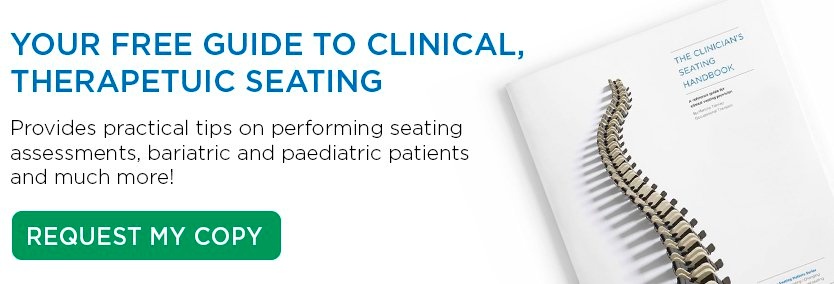What's in a name?
As clinicians, communication is a fundamental aspect of our work. Whether we are caring for our patients, advising on their treatment or planning for the future, the terminology we use has a profound impact on patient outcomes.
FREE RESOURCE: THE CLINICIAN'S SEATING HANDBOOK
But in this global, connected world, the terminology we use when referring to medical conditions isn’t always translated universally.
In this video, we discuss how a change in terminology is having a significant, positive impact on patient care.
WATCH: Martina Tierney OT and Patti Burke-Martin, Clinical Director, discuss the changing terminology used when talking about pressure ulcers
The History
For many years, the painful wounds on patient’s bodies were referred to as “bed sores” or “decubitus ulcers” from the Latin verb decumbere meaning “to lie down” (Parish & Witkowski, 2004). In fact, scientific writings of the 19th Century observed that pressure ulcers have probably existed since the early recorded history of mankind. The findings have been observed in unearthed human mummies as old as four thousand years (Levine, 2005).
Until the early twentieth century, these wounds were observed mostly in bed bound patients during the last period of their illness (Bansal et.al, 2005). This is one reason why the term “bedsore” was so widely used.
 The use of this term contributed to the misconception that these wounds have developed solely from extended periods of bed rest, and therefore, that the bed and the mattress was the primary solution to this issue.
The use of this term contributed to the misconception that these wounds have developed solely from extended periods of bed rest, and therefore, that the bed and the mattress was the primary solution to this issue.
Referring to pressure ulcers as “bedsores” is now considered to be antiquated. The name “pressure ulcer” instead of “bedsores” or decubitus, was accepted as the term that should be used during a Biomedical International Conference in Baltimore in 1975 (Kenedi et.al, 1976). Since then “pressure ulcer” is the term that has most commonly been used internationally.
The term “pressure ulcers” reflected the facts that skin damage was not only an issue to be treated through the use of the bed and the mattress, but that other treatment modalities, such as effective repositioning, off-loading of the body, hydration, nutrition and proper seating could help in the management and treatment of pressure ulcers.
In more recent years, the definition of a “pressure ulcer” or “pressure sore” has has been refined. The most recent definition from the UK National Pressure Ulcer Advisory Panel states that a pressure ulcer is, “a localized injury to the skin and/or underlying tissue usually over a bony prominence, as a result of pressure, or pressure in combination with shear and/or friction...” (EPUAP/NPUAP, 2007).
Putting the Term "Bedsores" to Bed?
At present, there is a move towards the re-naming of pressure ulcers to “pressure injuries” (PI). The term pressure injuries indicates that a PI is considered to be preventable and recognizes that ulcers are only one form of a pressure injury (NHQSH, 2011). This term “pressure injury” is already being used in common clinical practice in Australia and New Zealand over the past number of years.
Perhaps in the near future we will see other national and international bodies accept this terminology and have the standard definition changed across the world. As clinicians, we need to embrace new clinical practice, such as this change of definitions, as we endeavour to change the lives of our patients.
I and my Clinical Team use this terminology when we educate our fellow clinicians about the prevention of pressure ulcers. We believe that by joining our colleagues in Australia, New Zealand and the United States in using the term “pressure injuries”, it will have a positive impact on patient care and help change the perception and attitudes towards pressure injuries.
It is my prediction that in the near future, the term ‘bedsore’ and “pressure ulcer” will no longer be part of the vocabulary and “pressure injury” will be the common term used worldwide.
I think that although the change in name from pressure ulcer to pressure injury is a small linguistic change, this could potentially have a dramatic impact on patient care. It will refocus people’s attention to the fact that the majority of pressure ulcers are completely avoidable and that oftentimes, steps can be taken to prevent it from happening at all. It’s positive to see that our clinical colleagues in Australia and New Zealand are already using this terminology with some positive results.
- Martina Tierney
Join us in our journey, where we see a world without pressure ulcers and work on a common goal to eradicate pressure injuries. For further reading on pressure injury preventing and staging guidelines, request a free copy of The Clinician's eating Handbook.
LEARN HOW TO REDUCE PRESSURE INJURIES WITH
THE PREMIER RESOURCE IN CLINICAL SEATING
REFERENCES
Bansal. C., Scott. R., Stewart.,D and Cockerell C.J. (2005) Decubitus ulcers: A review of the literature. Int J Dermatol;44:805-10.
European Pressure Ulcer Advisory Panel and National Pressure Ulcer Advisory Panel (EPUAP/NPUAP). (2009). Assessment and treatment of pressure ulcers: quick reference guide. Washington DC: National Pressure Ulcer Advisory Panel.
Kenedi R.M., Cowden. M, Scales JT, (1976) Eds Bedsore Biomechanics. Baltimore: University Park Press, 1976.
Levine J.M. (2005). Historical perspective on pressure ulcers: the decubitus ominous of Jean-Martin Charcot. J Am Geriatric Soc ;53(7):1248-5.
National Safety and Health Service Standards. (2011) Australian Commission on Safety and Quality in Health Care. [Online] Available from: http://www.safetyandquality.gov.au/wp-content/uploads/2011/01/NSQHS-Standards-Sept2011.pdf [Accessed 1 March 2016].
Parish L.C., & Witkowski J.A. (2004) Controversies about the decubitus ulcer. Dermatol Clin ;22(1):87-91.
Prentice, J.L & Stacey, M.L. (2001) Pressure ulcers: the case for improving prevention and management in Australian health care settings. Pressure ulcers: improving prevention and management. Vol. 9, No. 3. pp 116.
*Note - the purpose of this blog is to give an overview of the product with some tips to consider on its use. This is not intended to be a substitute for professional or medical advice, diagnosis, prescription or treatment and does not constitute medical or other professional advice. For advice with your personal health or that of someone in your care, consult your doctor or appropriate medical professional.





